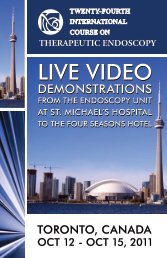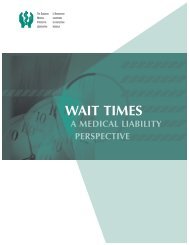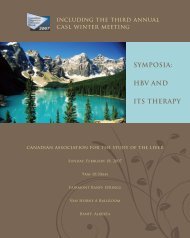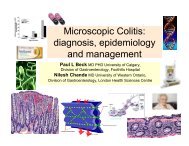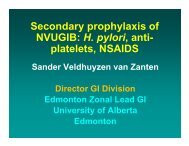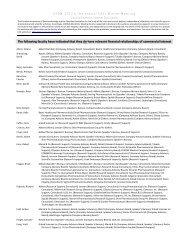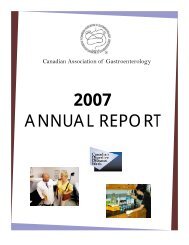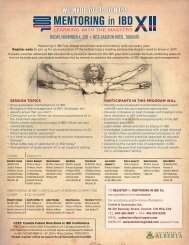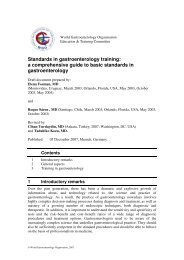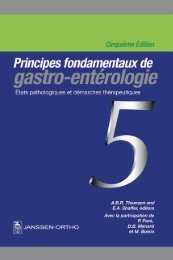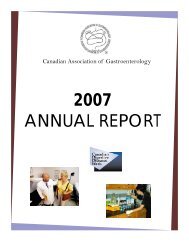Manifestations of Gastrointestinal Disease in the Child
Manifestations of Gastrointestinal Disease in the Child
Manifestations of Gastrointestinal Disease in the Child
Create successful ePaper yourself
Turn your PDF publications into a flip-book with our unique Google optimized e-Paper software.
686 FIRST PRINCIPLES OF GASTROENTEROLOGY<br />
abnormalities, Mallory-Weiss tears and aspiration <strong>of</strong> gastric contents. It is<br />
important to develop an approach to <strong>the</strong> child who presents with chronic vomit<strong>in</strong>g<br />
that allows for rapid diagnosis and assessment <strong>of</strong> <strong>the</strong> degree <strong>of</strong> sickness<br />
with m<strong>in</strong>imal <strong>in</strong>vestigation.<br />
2.1.2 PATHOPHYSIOLOGY<br />
The response <strong>of</strong> vomit<strong>in</strong>g is mediated by neural efferents <strong>in</strong> <strong>the</strong> vagal, phrenic<br />
and sp<strong>in</strong>al nerves. The complex neurohumoral bra<strong>in</strong>-gut <strong>in</strong>teractions are coord<strong>in</strong>ated<br />
<strong>in</strong> <strong>the</strong> medulla. The process <strong>in</strong>volves retrograde peristalsis, coord<strong>in</strong>ated<br />
abdom<strong>in</strong>al wall and respiratory movements with result<strong>in</strong>g forceful expulsion <strong>of</strong><br />
<strong>the</strong> contents <strong>of</strong> <strong>the</strong> stomach through <strong>the</strong> mouth. This is a protective reflex s<strong>in</strong>ce<br />
it promotes rapid expulsion <strong>of</strong> <strong>in</strong>gested tox<strong>in</strong>s or relieves pressure <strong>in</strong> hollow<br />
organs distended by distal obstruction. The vomit<strong>in</strong>g reflex may cause nausea,<br />
gastric atony, and signs and symptoms <strong>of</strong> autonomic excitation such as<br />
<strong>in</strong>creased salivation, sweat<strong>in</strong>g, pupil dilatation, changed heart rate and respiratory<br />
rhythm.<br />
2.1.3 CLINICAL EVALUATION<br />
Vomit<strong>in</strong>g is a nonspecific sign. It is a prom<strong>in</strong>ent feature <strong>of</strong> many disorders<br />
<strong>of</strong> o<strong>the</strong>r systems <strong>in</strong>clud<strong>in</strong>g, renal, neurologic, metabolic, endocr<strong>in</strong>e and <strong>in</strong>fectious<br />
disorders. Although it is a diagnostic challenge, <strong>the</strong> etiology <strong>of</strong> most<br />
vomit<strong>in</strong>g can be determ<strong>in</strong>ed by history and physical exam<strong>in</strong>ation.<br />
A number <strong>of</strong> features are particularly helpful <strong>in</strong> reach<strong>in</strong>g a diagnosis:<br />
These <strong>in</strong>clude:<br />
1. Age <strong>of</strong> <strong>the</strong> patient<br />
2. Associated signs and symptoms<br />
3. Temporal pattern <strong>of</strong> vomit<strong>in</strong>g<br />
2.1.3.1 Age<br />
Vomit<strong>in</strong>g <strong>in</strong> <strong>the</strong> neonatal and early <strong>in</strong>fant period may frequently be due to congenital<br />
obstructive gastro<strong>in</strong>test<strong>in</strong>al malformations such as atresias or webs <strong>of</strong><br />
<strong>the</strong> esophagus or <strong>in</strong>test<strong>in</strong>es, meconium ileus, or Hirschsprung’s disease.<br />
Inborn errors <strong>of</strong> metabolism and endocr<strong>in</strong>e disorders such as adrenal <strong>in</strong>sufficiency<br />
<strong>of</strong>ten present with prom<strong>in</strong>ent vomit<strong>in</strong>g <strong>in</strong> <strong>the</strong> neonate (Table 1). Some<br />
conditions will occur <strong>in</strong> specific age ranges: pyloric stenosis at two to eight<br />
weeks <strong>of</strong> age; <strong>in</strong>tussusception at three to 18 months. Appendicitis is rare<br />
before <strong>the</strong> age <strong>of</strong> 12 months.<br />
2.1.3.2 Associated symptoms and signs<br />
Associated symptoms <strong>of</strong>ten provide important diagnostic clues (Table 2). For<br />
example bile-sta<strong>in</strong>ed vomitus suggests <strong>in</strong>test<strong>in</strong>al obstruction distal to <strong>the</strong>



